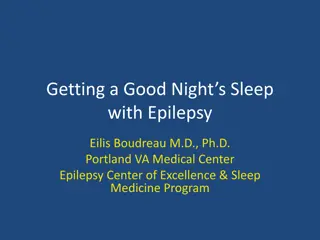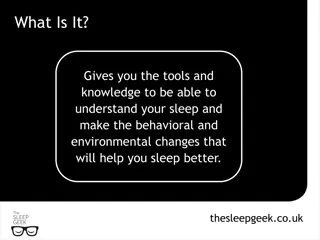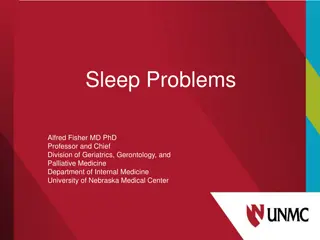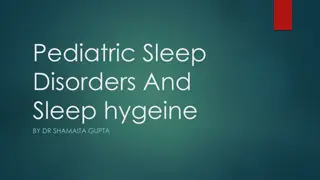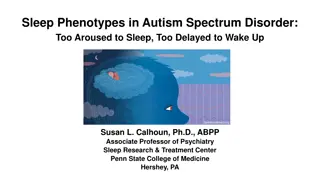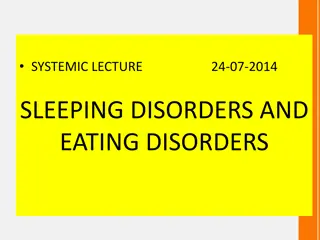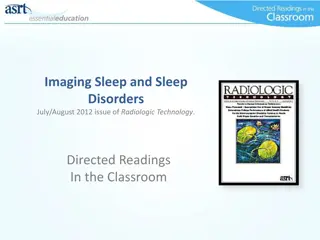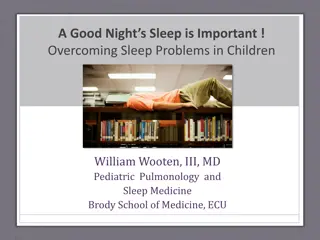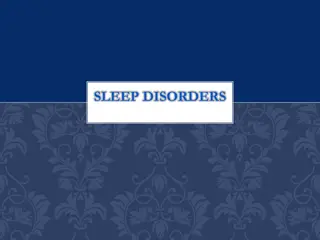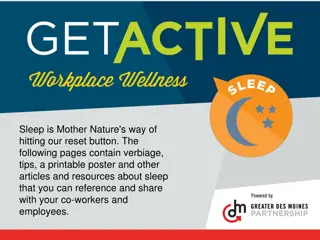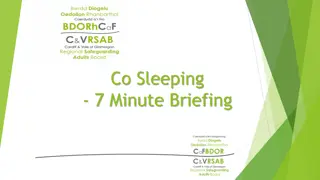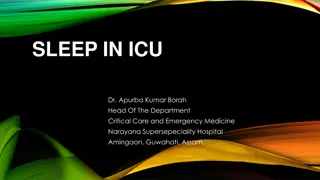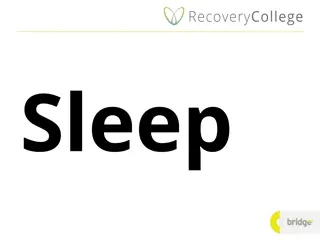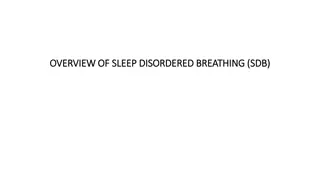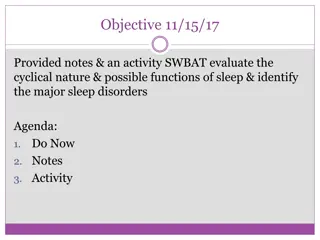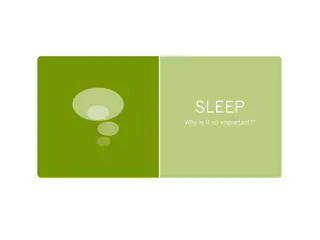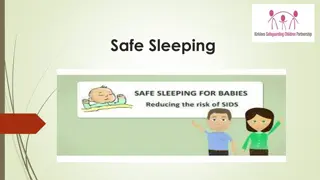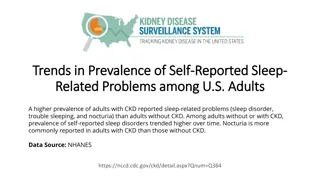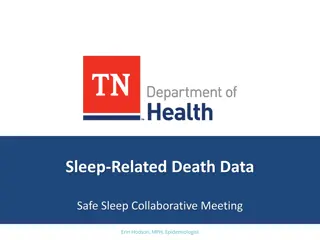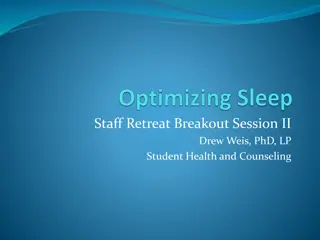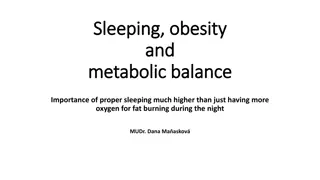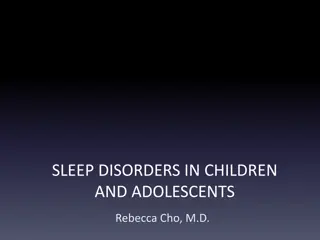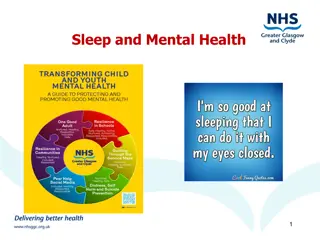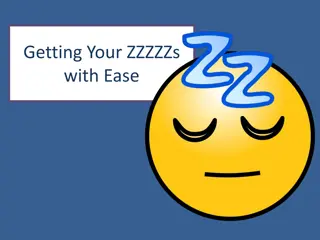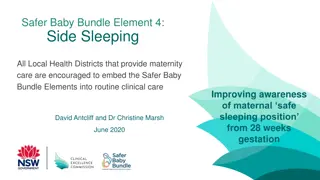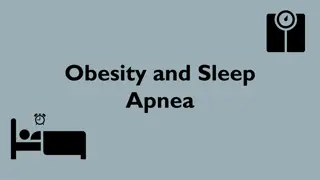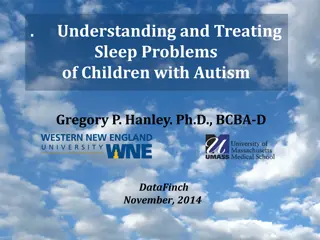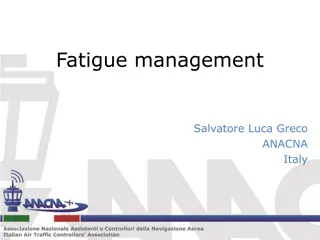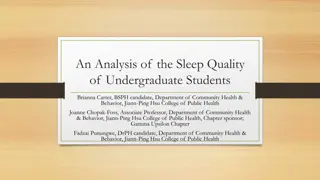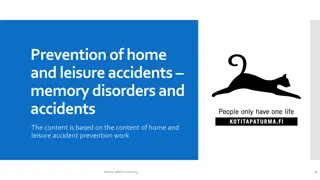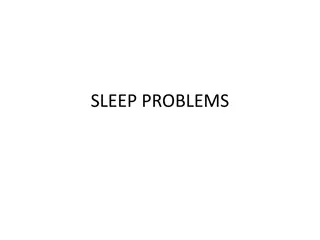Exploring Sleep, Dreams, Sleeping Disorders, and Memory: Different Approaches and Key Studies
This informative content delves into the topics of sleep, dreams, sleeping disorders, and memory, examining the Biological, Cognitive, and Psychodynamic approaches. Key studies and explanations are provided for each, including insights into biological rhythms, brain activity during sleep, and the role of internal and external factors in regulating our sleep-wake cycles.
Download Presentation

Please find below an Image/Link to download the presentation.
The content on the website is provided AS IS for your information and personal use only. It may not be sold, licensed, or shared on other websites without obtaining consent from the author. Download presentation by click this link. If you encounter any issues during the download, it is possible that the publisher has removed the file from their server.
E N D
Presentation Transcript
Sleep, Dreams and Sleeping Disorders and Memory. You will need to know: How 3 different approaches attempt to explain each topic. At least 2 key studies for each topic.
We will look at: Biological Approach Cognitive Approach Psychodynamic (psychoanalytic) approach
This approach believes that all behaviour is a result of systems within the body: Genes (hereditary) Biochemical Imbalance (e.g hormones) Neuroanatomy Problems.
Last approx. one day. Sleep and wake cycle body temp, urine production, etc. This is called homeostasis the control of internal conditions. Endogenous pacemakers internal biological rhythms. Exogenous zeitgebers external factors which affect our biological rhythms
Internal or External? Siffre, 1975 When people deprived of zeitgebers they still maintain a cyclical rhythm but it extends to 25 hours. Internal and external factors work in unison. Menaker et al, 1978 cut the suprachiasmatic nucleus (SCN the brain s internal clock, a bundle of nerves situated in the hypothalamus) from a hamster s brain and found a disruption to the hamster s circadian rhythms
The SCN The main Endogenous Pacemaker Neurones project from the SCN to the pineal gland which releases melatonin to induce sleepiness.
Biorhythm that lasts less than 24 hours, eg brain activity during sleep. Electroencephelogram (EEG) measures the varying brain activity during sleep and has found 5 stages. The first four and non REM (nREM) stages in sleep gets progressively deeper The final stage is REM sleep paralysis, eye movement, dreaming. EEG activity would suggest that person is actually awake.
Light Light can be detected through other areas of the body, not just the eyes, and can be a powerful zeitgeber. Campbell and Murphy, 1998- found that shining lights on the back of knees could alter circadian ryhthms.
Social Factors Luce and Segel, 1966. People who live in the Arctic Circle maintain a constant sleep pattern despite 6 months of constant darkness in the winter. This suggests that social factors can override light as a powerful zeitgeber.
Stimulants and Depressants Alcohol decreases time taken to fall asleep but lessens the amount of time spent asleep. Caffeine - While a little caffeine increases wakefulness, too much can cause insomnia, jitters, headaches, irregular heartbeat, racing heart and anxiety. Avoid caffeine after 4pm! Nicotine The addictive affect of nicotine means that smokers tend to wake in the night craving cigarettes (30 mins-2 hrs after last cigarette. Smokers are much more likely than non smokers to report trouble falling and staying asleep (Philips and Danner, 1995)
Problems can occur when disruption to rhythms happen quickly eg jet lag and shift work. Problems include poor attention span, impaired reaction time and reasoning skills. Going from East to West causes minimal issues gain time. However, going from West to East means you lose time and that s when problems occur. In the East it is night time but you have just come from the West your temp and metabolic rate is at it s peak making it difficult to fall asleep.
Schwartz et al, 1995. Studied baseball teams from West and East coast of America. East coast teams who were playing on the West coast won significantly more games than West coast teams playing on the East coast.
Chemicals Melatonin supplements can help to reset the body clock. Used by American military pilots. However, these are not yet licensed in the UK. Light The SCN is sensitive to light and this can contribute to jet lag. SIK1 is a protein that can counteract the affects of light. A 2013 study at Oxford Uni reduced the SIK1 in mice and then exposed them to artificial light to recreate the feeling of jet lag. The reduction in SIK1 meant that it took them just 6 hours to recover rather than the usual 6 days. Food fasting can also alter biorhythms and therefore help to counteract jet lag.
More frequent shift changes result in more negative effects. Eg fatigue, sleep disturbance, memory loss, mood swings, reduced productivity and low staff morale. Major industrial disasters, eg Chernobyl, tend to happen in the early hours as well as fatal car accidents.
Czeisler, et al, 1990. Exposure to bright light and darkness to treat physiologic maladaptation to night work. Aim to evaluate if exposure to bright light at night and darkness in day can treat maladaptation due to night work. PPT 8 men 22-29 years old. Method 2 week study. Control condition and treatment condition
1st week baseline study 2nd week night shift work. Results Treatment study slept for 2 hours longer than control. Sig. shift in body temp nadir between week 1 and 2 and between control and treatment condition. Behavioural changes same behaviour shown but shown later in treatment condition. Alertness Treatment condition sig higher than control by end of week 2.
Conclusion Maladapatation of the human circadian rhythm to night work, with its associated decline in alertness performance and quality of daytime sleep can be treated effectively with scheduled exposure to bright light at night and darkness during the day. Evaluation?
Ecological Theory We adapt and evolve to fit in with our environment. Meddis, 1979 Protection theory length of sleep depends on whether the animal is predator or prey. Prey sleep less because they are vulnerable. Webb, 1982 hibernation theory sleep to conserve energy when there is little food (winter). Sleep lowers metabolic rate.
Restoration Theory of Sleep. Oswald, 1966 Sleep restores depleted resources of energy, repairs cells and restores homeostasis. During nREM sleep body releases more growth hormone which could help to restore cells. Shapiro, 1981 studied ultra marathon runners and found that for the next 2 nights they slept for approx 90mins longer than usual. Stage 4 nREM sleep (when growth hormone is released) increased from 25% of sleep to 45%. REM sleep decreased.
Restoration theory contd. Oswald and Hartman, 1984 extended this theory to look at REM sleep and how it helps to restore the brain. Sterne and Morgan, 1974 neurotransmitter levels restored during REM sleep. Would explain why babies spend 9 hours of their day in REM sleep compared to adults 2 hours their brains are still growing and developing.
Restoration theory supporting evidence. Disruption at stage 4 = fibrositis (lower back condition caused by muscle wasting) Following trauma to the brain people spend longer in REM sleep for next 6 weeks. Explains different sleep needs for different life stages. How does it explain the varying sleep patterns of different animals if sleep only serves this one purpose? Eg lions sleep lots, herbivores sleep little lifestyle seems to explain this more than just endogenous factors.
I have asked you to keep a diary of your dreams for the last week. Think about the dreams you have had so far, can you make sense of them? Are they organised or bizarre and random? Can you make links between them and what has happened through the day? Does there seem to be any links between the content of dreams? What do you think has caused them?
Series of visual images, actions and emotions. Not just images blind people have been shown to have just as vivid dreams even though they don t see anything. Nightmares are much more likely if the person is anxious during waking hours and people who are feeling sad or depressed are more likely to have dreams about loss and failure (Oswald 1980)
Dement and Kleitman, 1957 Aims (1) to find a correlation between REM sleep and dreams, (2) the estimation of duration of dreams and length of eye movement and (3) association between the pattern of eye movement and context of dream. See handout
Hobson and McCarley, 1977 Based on many years of electrophysiological research into the brain mechanisms. Random bursts of neural activity are made sense of by the brain and expressed through dreams. Integrates sensory and motor information with memories and expectations.
Activation = entering into REM sleep triggers the mechanism based in the brain stem which arouses the sensory and motor information which forms the basis of our dreams. Synthesis = how we make sense of this activation and how it is expressed in your dream. Eg if neurons are fired into the part of the brain that is responsible for balance we might dream that we are falling.
Gillin et al, 1985 injection of the neurotransmitter acetylcholine (responsible for initiating REM sleep) increased both the amount of REM sleep and dreams supporting the idea that neurons are indeed responsible for our dreams. However, dreams are sometimes influenced by real events. How can random firing explain this?
Crick and Mitchison, 1983 While we dream the brain sifts through the information and gathers inform and gets rid of any unwanted material We dream to forget . Information creates a physical connection in the brain which can overload our cortex and disrupt the efficiency and organisation of memory if not cleared out . These networks are erased by impulses bombarding the cortex. The content of dreams represents these parasitical thoughts and are wiped from the memory.
Crick and Mitchison believed that the fact that spiny anteaters and dolphins don t dream supports their theory. Both of these animals have relatively large frontal cortexes. Possibly to store all the information they can t lose during sleep? However, not all dreams are random some have a clear narrative to them. How can this theory explain these kind of dreams? In 1986 they revised their theory to only include bizarre imagery dreams.



